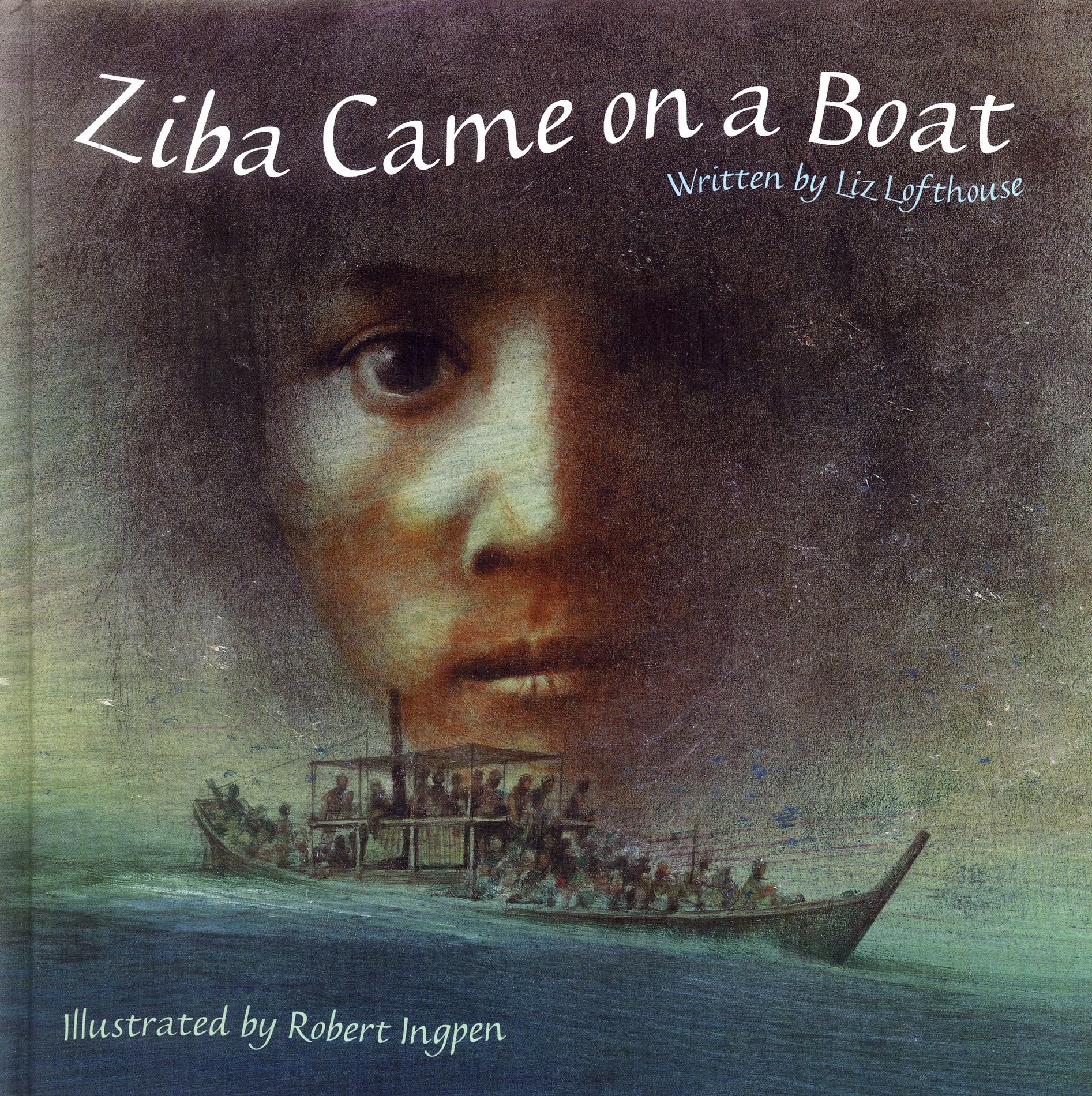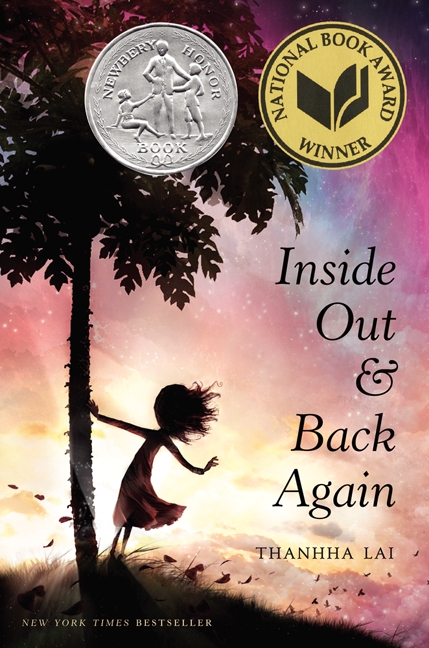By Lauren Freedman
This week, I am sharing works of fiction, nine picture books with illustrations that deepen the reader’s empathy and understanding and four chapter books, all written in free verse. The free verse, I think, captures the shifting emotions and swift changes in locations and circumstances the characters are experiencing and helps the reader feel part of the story. Though fiction, all these stories are based on the real and often current experiences of refugees and immigrants from many parts of the world. For most of the books shared this week there are extension resources available on the internet.
Picture Books
Ziba Came on a Boat by Liz Lofthouse, illustrated by Robert Ingpen (2007)
This story is about a girl who flees from her war torn home on a crowded, rickety boat. The words and beautiful watercolor illustrations work to make the reader feel the upheaval, fear, fortitude, and bravery that this young refugee feels as she thinks about her past and imagines her future as she travels over a long distance seeking solace and asylum.
Four Feet, Two Sandals by Karen Lynn Williams and Khadra Mohammed, illustrated by Doug Chayka (2007)
This story is about a friendship that develops between two girls who share a pair of sandals they have received as part of the donations given out in their refugee camp in the middle east. It affirms that even amid loss and hardship, friendship goes a long way toward easing suffering and at least making it bearable.
My Name is Sangoel by Karen Lynn Williams and Khadra Mohammed, illustrated by Catherine Stock (2009)
This book captures the importance of names for maintaining identity and a sense of self. Most importantly for refugees, names maintain their culture and keep near them those they have left behind and may never see again. When Sangoel gets to the United States from Sudan, he helps his classmates learn his Dinka name in a very inventive way. His classmates, in turn, use his strategy for helping him to pronounce their names. In an author’s note at the end, the author includes facts about refugees from Sudan.
Brothers in Hope: The Story of the Lost Boys of Sudan by Mary Williams, illustrated by R. Gregory Christie (2005)
This books is based on the story of Garang and the other “lost boys” he leads as they flee Sudan. At first they find a refugee camp in Ethiopia but the soldiers again force them to flee. This time traveling by night and sleeping by day, they make it to Kenya where they find another refugee camp. Here they meet Tom who helps them to see the value in themselves and in education. After Tom leaves, Garang works to help other boys as they too find the camp. As an adult, Garang becomes one of the 3,800 “Lost Boys” to be resettled in the United States.
My Name is Bilal by Asma Mobin-Uddin, illustrated by Barbara Kiwak (2015)
This story, in contrast to My Name is Sangoel, is about a boy who at first sees his name as a deficit as he struggles to fit in with the other students at his new school. After seeing his older sister being bullied, he decides that he should use the name Bill instead of Bilal. A teacher who is also Muslim helps him to understand the history and significance of his name.
Mama’s Nightingale: A Story of Immigration and Separation by Edwidge Danticat, illustrated by Leslie Staub (2015)
While Saya’s mother is in an immigration detention center, Saya learns the power of story to ease her loneliness and separation. While Saya’s father works to reunite the family, her mother sends cassette tapes she has recorded telling Saya Haitian folktales. This is comforting for Saya and leads her to tell a story of her own.
Playing War by Kathy Beckwith, illustrated by Lea Ly (2005)
Luke and his friends decide one day to play their favorite game — war. Sameer, new to the neighborhood, isn’t sure he wants to play and tells the boys about his experiences with war — real war. This enables the boys to think about war in new ways and to understand the suffering associated with war.
The Roses in My Carpets by Rukhsana Khan, illustrated by Ronald Himler (2004)
Set in a refugee camp, this story depicts the power of dreams of freedom and safety and plenty to offer comfort and possibility amid the daily hardships and struggles for mere survival. It depicts the power of human beings to remain hopeful even in the direst of circumstances.
Novels in Free Verse
Inside Out & Back Again by Thanhha Lai (2011)
This is the story of a Vietnam refugee, Ha, who escaped with her family to Alabama. The book is divided into three parts: Saigon, At Sea, Alabama. The poetry is sparse, yet envelops the reader in Ha’s experiences as she leaves her precious Vietnam and all she has known for 10 years for a long journey, and the hard and demanding work of building a new life in a strange land.
The Good Braider by Terry Farish (2014)
Viola and her traditional Sudanese mother travel from Sudan to Cairo to Portland, Maine where they confront a culture vastly different from their own. Viola must navigate the space between her new world and the world of her past and her mother. The poetry brings the reader into Viola’s world and her conflicts and enables the reader to experience her life with her.
Home of the Brave by Katherine Applegate (2007)
Kek is sent to Minnesota from Africa after having lost his family including his mother who may or may not be alive. He sees snow for the first time and has a strong penchant for the cow he sees that reminds him of home. As he meets new people, he builds friendships that give him the resiliency to build a new life in his new country. The precision of the poetry and carefully chosen words convey Kek’s experience with depth and empathy.
The Red Pencil by Andrea Davis Pinkney (2015)
At age 12, just as she is about to go to the school that accepts girls, Amira’s life is turned upside down when the Janjaweed attack her town in Sudan. She and her family must flee on foot from their South Darfar farm and seek safety in an overcrowded refugee camp. Told in the first person, Amira’s misery begins to find relief when an aid worker in Kalma camp gives her a yellow pad and a red pencil.
Next week for the final December installment, I will share four books published in 2016 as well as some resources that can be used to investigate further and become involved in the movement to make today’s refugees welcome and secure as they build lives in the United States.
Journey through Worlds of Words during our open reading hours: Monday through Friday 9 a.m. to 5 p.m., Saturday 9 a.m. to 1 p.m. Check out our two online journals, WOW Review and WOW Stories, and keep up with WOW’s news and events.
- Themes: Lauren Freedman
- Descriptors: Books & Resources, Debates & Trends, WOW Currents


